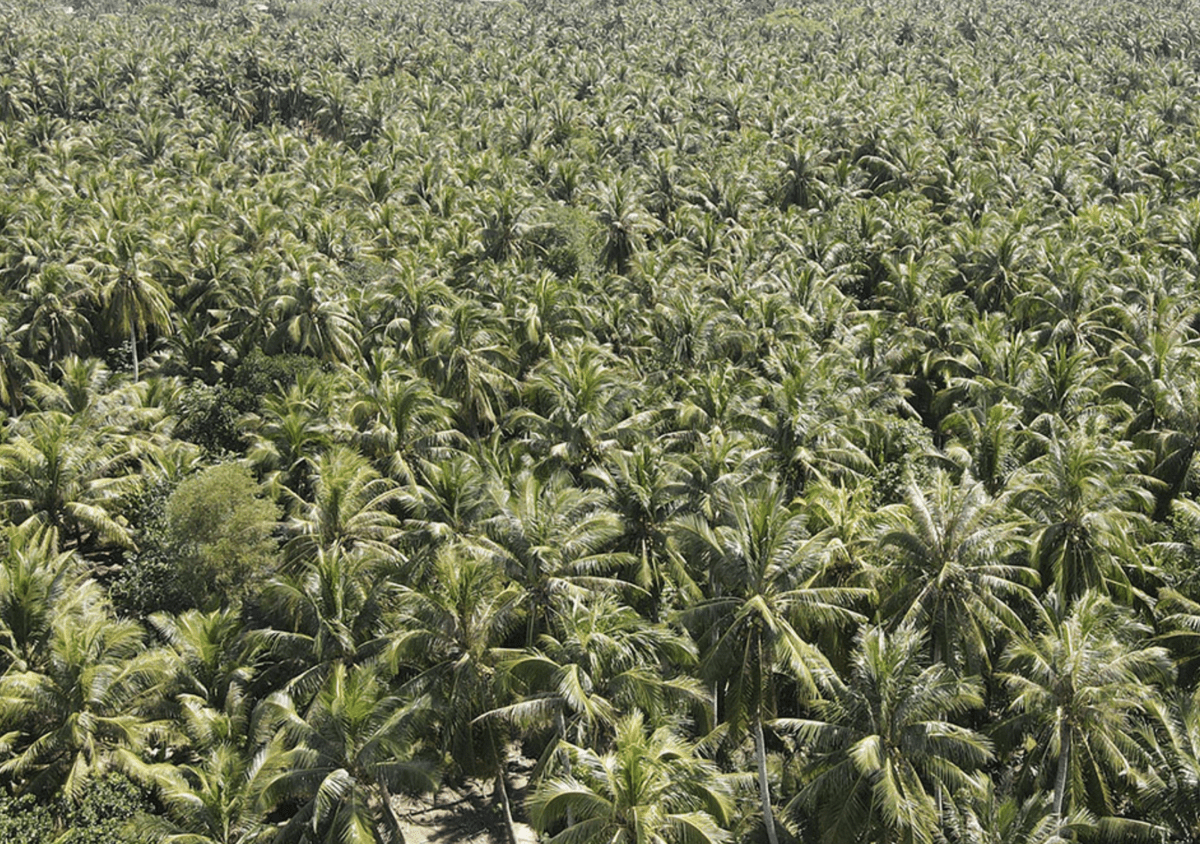
More recently, the agriculture sector launched the project on developing 1 million hectares of high-quality and low-emissions in the Mekong River Delta. Deputy Minister of Agriculture and Rural Development Tran Thanh Nam said Vietnam’s first low-emission rice will be produced by August 2024.
Mekong Delta is not only a rice granary, but also the homeland of coconut trees. All parts of coconut trees, from trunks to leaves and flowers, can be used to create added value products. And farmers can also obtain carbon credits from coconut plantation.
At Sokfarm, owned by Thach Thi Chal Thi and Pham Dinh Ngai, organic coconut trees are planted for nectar. From nectar, they can make a wide range of products, from soy sauce, honey vinegar, molasses, fermented coconut nectar, cocoa beans and coconut flower nectar.
According to Ngai, a cluster of coconut flowers can create about 10 coconuts, which can sell for VND50,000. Meanwhile, if using the flowers for nectar, a cluster of flowers can bring 25 liters of nectar, worth VND250,000. As such, a farming household can earn up to VND6 million a month if they have 20 coconut trees.
Sokfarm has 50 households growing organic coconut in accordance with international standards for nectar.
Chal Thi said climate change is getting severe and coconut is a kind of tree that sustain drought and saline intrusion in Mekong Delta. Sokfarm aims to have 500 farming households by 2030 and 1,000 households by 2035 to grow coconut trees.
Growing coconuts not only brings money from nectar exploitation, but also makes a great contribution to fight against climate change. Ngai and his wife are seeking information and following procedures to be able to sell carbon credits from coconuts.
It is estimated that every coconut tree, after 10 years of growing, can create the number of carbon credits worth $1 per tree. The farm now has 25,000 coconut trees more than 10 years old, which can bring at least $25,000 to farmers. Meanwhile, they are growing more and more coconut trees every year.
In mid-April, Ben Tre province began assessing its potential to join the provincial carbon market. Local agencies are researching and building Ben Tre provincial carbon credits in some fields, with focus on coconuts.
Amid the trend for sustainable development and emission reductions, carbon credits have become an attractive opportunity for the agriculture sector and coconut specialized growing area in Ben Tre.
Ben Tre now has over 79,000 hectares of coconut growing area and is estimated that one hectare of coconut can contain 25-75 tons of CO2. With a carbon credit price of $5 per ton of CO2 at minimum, Ben Tre can collect $10-30 million from coconut trees.
Additional income from coconut carbon credit sale
In Vietnam, coconuts are a key agricultural crop. Vietnam now ranks seventh in the world in coconut production with a growing area of 188,000 hectares, mostly located in the provinces of Ben Tre, Tra Vinh, Tien Giang and Vinh Long.
In 2023, coconut exports brought turnover of $900 million to Vietnam. According to Nguyen Thi Kim Thanh, chair of the Vietnam Coconut Association, Vietnam’s coconut export turnover may reach $1 billion by the end of 2024.
Thanh said the products made of coconut are diverse, from food to handicrafts, creating livelihood for 390,000 Vietnamese households.
The economic value of coconut trees will be increasing further thanks to coconut carbon credit sales. Vietnam has committed to cut greenhouse gas emissions to zero by 2050. Meanwhile, one hectare of coconut trees can absorb 70-75 tons of CO2 each year.
An expert has estimated that with the existing coconut growing area and the carbon absorption capability of the tree, if Vietnam sells coconut carbon credits at prices equal to forest carbon credits, the country would earn trillions of dong more each year.
However, Tran Minh Hai from the School for Public Policies and Rural Development, pointed out that to create carbon credits from coconuts, farmers need to change their cultivation methods and use new technologies to reduce greenhouse gas emissions.
Tam An